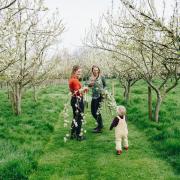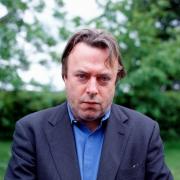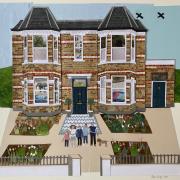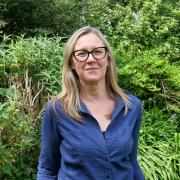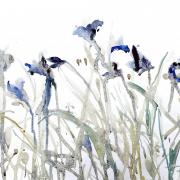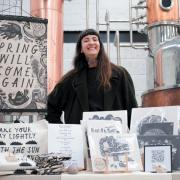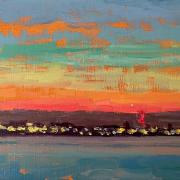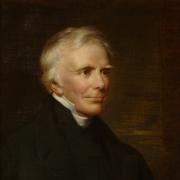Nine months ago, artist Stephen Turner embarked on a unique project, to live and work for a year inside a giant floating wooden egg on the Beaulieu Estuary. Is he still riding high on the crest of a wave or has this hermit’s existence left a sinking feeling? Viv Micklefield tracks him down

We might think of our home as our castle, yet for one man it’s an egg: a six by three metre custom-built egg to be precise. But whilst this may lack many mod-cons, the minimalist design has enabled its temporary tenant to establish a connection with his natural environment. And by doing so, in a low-impact, self-sustaining way, record the changing landscape of a very special stretch of Hampshire coastline.
Each year, Exbury Gardens near Beaulieu welcomes visitors from around the world who flock to enjoy its famous collections of specimen plants. Under the watchful eyes of estate owner Nicholas De Rothschild, wildlife conservation is important here. Still, it remains a surprise that, tethered on a private mooring and hidden from public gaze, is a structure not out of place on a Jurassic Park film set. Bobbing as it does on the tide; the choice of an egg shape is no coincidence. Its inspiration comes from the nesting seabirds that, alongside the diverse flora, fauna and insects, inhabit these ancient salt marshes.
“If the ‘Exbury Egg’ symbolises fertility, birth and renewal, it is, equally, a reminder of our difficult relationship with nature and of the heavy footprints that mark our path as we bestride the planet,” says 59 year-old artist Stephen Turner, who, once the 12 months are up, will return this site to its former solitude, with no trace of his occupation.
Meanwhile, it’s as the self-styled Beaulieu Beadle, or custodian, of this watery abode that Stephen is using his home come ‘laboratory’ to surf the boundaries between art and science. But it’s a squeeze. His ever-expanding collection of estuary flotsam and jetsam sees boxes containing mice skeletons re-assembled like Airfix kits, jostling with supplies of tinned vegetables. On another surface, pots of drawing ink made from oak trees rub shoulders with camera and GPS equipment. While bunches of water lavender dry alongside laundry.
The cedar-clad Egg made by local boat-builder Paul Baker and modelled on a traditional riverboat’s construction, is a thing of beauty. How many of us though would be content cooking on a two-ring stove, or washing with a garden pressure spray and outside hosepipe? Yet Stephen has made surprisingly few modifications since last summer’s maiden voyage from Lymington Yacht Haven. “I now sleep with my head very close to the Egg’s shell,” he explains, via a Skype call. Having ditched the original hammock supplied, which gave him backache, a homemade bed enables him to tune-in to his surroundings: “Now, being only inches away, I pick up the sounds outside. When rain hits the wood it’s a bit like being in a tent, and when the tide’s out the water percolates through the estuary’s channels creating a popping sound.
“I feel a kinship with the early morning calls of birds. They and I respond to a predawn glow in the eastern sky as a precursor of the day ahead.” And becoming sensitive to the ebb and flow of the seasons has affected his behaviour.
Summer swims at high tide gave way to autumn foraging - jars of rosehip conserve and bottles of blackberry wine just some of the products of his bounty. Paddling his inflatable kayak to explore an outer bank has been replaced by more frequent walks across the mudflats at low tide. And while he’s still gathering, geo-tagging and researching the detritus that’s washed-up, blown or dropped into his line of vision, Stephen’s focus has been transformed. “I imagined my “parish” to be about three-quarters of a mile to the south and about a quarter of a mile across,” he observes. “What’s been happening is that rather than roaming far and wide, I’m now looking much more intensely at just a small area of ground on a regular basis.”
Shorter days with distant lights soon winking at the Egg from far across the Solent, have also brought new nocturnal patterns. ”I’ve been going to bed at 5pm » and getting up at 7am so am getting between 12 to 14 hours sleep a night which, for me, is unheard of,” Stephen laughs.
However, despite relishing the tranquillity that his enforced isolation from personal visitors brings, the website, www.exburyegg.com and regular blogs puts him under the microscope 24:7. This was, apparently, a conscious decision: “I thought if I’m intensely observing nature, that I should be observed as well. By sharing what is happening, hopefully, people will come to respect and to understand nature more themselves.”
It hasn’t taken long for the Egg to grab the Media’s attention too, including an appearance on George Clarke’s Amazing Spaces for Channel 4 TV. And within the local community, students of all ages continue to follow the Beadle’s discoveries with interest. Among these: climate change researchers at the University of Southampton; and a Solent University student who fashioned a bespoke wardrobe, including a cape made from recycled materials, for him to wear on his wanderings. Stephen might have become increasingly familiar with his surroundings but nature still has the capacity to surprise. Winter’s arrival, along with that of the Wigeon and Shelducks, saw the Egg’s solar-powered electricity supply prove unreliable. And when the worst storms in decades knocked-out his carefully positioned web cams, more connections faltered. Recent updates from Egg HQ provide further details: “Inside is reasonably warm with » the charcoal burning stove alight and the hatches battened down.” He then admits: “My mood turned chilly again when I discovered most of my clothing in my dry locker had become a thriving home to green and black mould.” Even the creative in him struggles to turn this unwelcome intruder into an art form!
Still the estuary’s distinctive ecosystem continues to distract from any physical set-backs. He speaks with obvious pleasure about finding marsh sow-thistle growing tall beside the entrance to the path down to the Egg; it appears to be a native plant which has been disappearing from elsewhere in the country. And he’s similarly enthusiastic about the chance to try his hand at making salt, in homage to the former Lymington salt pans that once occupied this site.
He’s a man who’s forged a career exploring the fragility of nature, in some of the world’s most out of the way spots. Yet, interestingly, Stephen confesses this experience, so far, has left him feeling he’s not quite the island he believed himself. But, adds: “It will be a wrench to leave a place that’s already become part of my DNA.”
------------------------------------------------------------------
Hatching the idea
The Exbury Egg is a collaboration of Stephen Turner, New Forest based PAD Studio and Romsey engineers EDP. Managed by Space Placemaking & Urban Design of Winchester, the project has been funded by Arts Council England, The Paul Hamlyn Foundation and Hampshire County Council. The Egg cost £40,000 to build and local businesses have also generously donated materials.
------------------------------------------------------------------
Get involved
Follow Stephen Turner at exburyegg.me or on Twitter @exburyegg.
Visit Exbury Gardens (inc. Exbury Egg Mission Control) which re-opens on Saturday 15 March, daily 10am-5pm. Exbury, Southampton SO45 1AZ. Tel: 02380 891203 www.exbury.co.ukStephen’s artwork will be exhibited at Exbury this summer. Details about this and where to see the Exbury Egg next are announced shortly.
Support the conservation work that protects nature reserves within the New Forest National Park at www.newforestnpa.gov.uk------------------------------------------------------------------
From the blog
“My exposed arm and nose felt like ice.… A curlew called from somewhere stage left …Grey light from the full moon streamed through the main skylight and I took its picture through a growing river of condensation. A triple spatter of droplets fell onto the plastic bag protecting my drawings as I crawled back under the covers.” 18 December 2013
“…the labyrinth spider is just one of my many parishioners. Its web inspired me to cut a new route to the Egg through bramble and blackthorn that is both more sheltered and less disturbing to the birds. It was slow work negotiating the sharp spines of the blackthorn.” 9 August 2013
Exbury Egg image credits: Nigel Rigden www.nigrig.com and Stephen Turner




